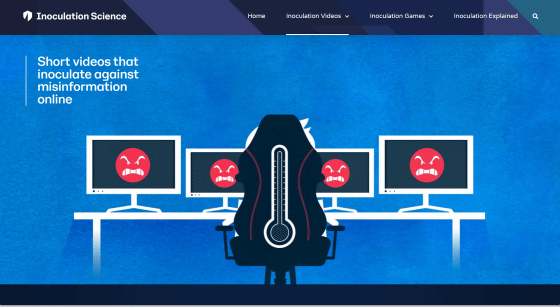An attempt to enhance the ability to see through fake news by streaming ``video explaining fake news tactics'' on YouTube advertisement

In recent years, the spread of fake news has become a global problem, and countermeasures against fake news have become an issue in the pandemic of the new coronavirus infection (COVID-19) and the 2020 US presidential election. According to a new study released by a research team at the University of Cambridge and a Google-related think tank, people's awareness of fake news can be raised by running ``videos explaining the tactics and characteristics of fake news'' as YouTube advertisements. was shown.
Psychological inoculation improves resilience against misinformation on social media | Science Advances
Short animations could 'inoculate' YouTube users against fake news | New Scientist
https://www.newscientist.com/article/2335170-short-animations-could-inoculate-youtube-users-against-fake-news/
Google is trying out 'pre-bunking' in an effort to counter misinformation
https://www.nbcnews.com/tech/misinformation/google-trying-pre-bunking-effort-counter-misinformation-rcna43818
A research team at the University of Cambridge's Social Decision-Making Lab and Jigsaw, a think tank under the umbrella of Google's parent company Alphabet, ``use words that appeal to emotions'' found in conspiracy theories and fake news. A 90-second video explaining tactics and characteristics such as ``lacking consistency'', ``setting up a false dichotomy'', ``creating a scapegoat'', and ``personal attacks rather than arguments''. created.
There are no specific politicians in the five videos that explain each topic, and instead characters from ' The Simpsons ', ' Star Wars ' and ' South Park ' appear. The actual created video is published on the following site.
Inoculation Science - Video Resources - Truth Labs for Education
https://inoculation.science/inoculation-videos/

The research team first conducted five different experiments, confirming the effect of the video on a total of about 6400 subjects. Subjects were divided into two groups: a group watching fake news videos and a group watching unrelated, harmless videos. was asked. As a result of the experiment, the subjects who watched the fake news countermeasure video successfully saw through the fake news they saw for the first time.
One year after the five experiments, the research team conducted another experiment under the same conditions to confirm the reproducibility of the effect. After that, we showed a fake news countermeasure video as ``ads that flow before YouTube video playback'' and conducted an experiment to investigate what kind of effect the video would have in an actual environment.
In a YouTube experiment, the research team used the same system as a regular advertising company to play fake news countermeasure videos, and it cost about 5 cents (about 7 yen) per playback. In total, nearly 1 million users watched at least 30 seconds of the 90-second video, and about 30% of randomly selected viewers received a survey ad asking about fake news tactics and characteristics a day later. displayed. In addition, the same questionnaire advertisement was displayed to users who did not watch the anti-fake news video in advance as a control group.
Analyzing the results of the questionnaire advertisement, it was found that users who watched the anti-fake news video in advance had a 5% higher ability to see the tactics and characteristics of fake news than the control group. ``We showed that these anti-fake news videos had a measurable and significant effect in the real world,'' said Jon Roozenbeek , a psychologist at the University of Cambridge and lead author of the paper.

The 'fact check' method of denying specific fake news can only be worked on after the fake news has actually spread. However, it is possible to respond to a wider range of fake news by appealing to users before the fake news flows, as in this experiment where we show a fake news countermeasure video. Also, since fact checks on specific topics often have political implications, measures to disseminate the tactics and characteristics often seen in fake news can avoid the problem of politicizing fake news. said to be beneficial.
In response to the results of this study, Google has already adopted this approach in three countries, Poland, Slovakia, and the Czech Republic, and is using it to suppress the backlash against Ukrainian refugees. The research team says that although this method is not planned to be adopted in the US midterm elections in the fall of 2022, it could become a standard option in the future.
On the other hand, the method of showing fake news countermeasure videos in advance is not very effective for people who do not trust the information provided by the government in the first place, and it was useful in stopping fake news issued by the far right and conspiracy theory influencers. It has also been pointed out that there may be no In addition, Shannon McGregor, a researcher at the University of North Carolina at Chapel Hill who was not involved in this study, argued that the research team should spend money on advertising on the platform to reduce the spread of fake news on SNS. I see it as a problem. “In many ways it is not satisfying for all stakeholders except the platform,” McGregor said.
Related Posts:
in Web Service, Science, Posted by log1h_ik







